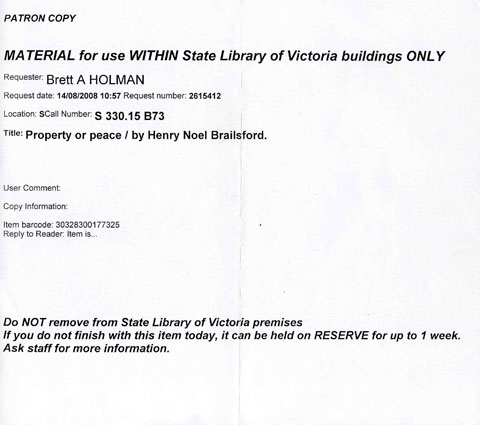
One of the fun things about reading old books that nobody else has opened for decades is what you sometimes find inside them: annotations, bookmarks, letters, racist leaflets (OK, that one was not so fun). Above is a library call slip (i.e. the bit of paper you fill in to request that a book be retrieved for you) from the SLV. I found it inside Property or Peace? by H. N. Brailsford, a socialist journalist. The book was published in 1934 but I reckon the call slip is from the 1950s, at the earliest, as there's a stamp in the front saying it was transferred from the CAE library in 1951 or 1952 or so.

This is the modern equivalent for the same book. Today books are requested electronically, through t he library catalogue; but it still gets turned into a printed call slip which you get with the book when it arrives. So the technology may have changed greatly, but the principle is just the same.
For some reason I was surprised to see that the call number of the book, S 330.15 B73, hasn't changed in the last half-century. Maybe there is a Law of the Conservation of Call Numbers?
![]() This work is licensed under a Creative Commons Attribution-NonCommercial-NoDerivatives 4.0 International License.
Permissions beyond the scope of this license may be available at http://airminded.org/copyright/.
This work is licensed under a Creative Commons Attribution-NonCommercial-NoDerivatives 4.0 International License.
Permissions beyond the scope of this license may be available at http://airminded.org/copyright/.

Jakob
Presumably the library is still using Dewey, rather than an updated version like UDC, so the call number wouldn't change.
Jonathan Dresner
I'm not convinced you're right about the dating of the call slip: there's nothing there to indicate that it's from the same library that you were using, and the writing looks an awful lot like fountain pen rather than ballpoint or marker.
Brett Holman
Post authorWell, I was thinking 1950s rather than 1980s, say; no reason why a fountain pen couldn't have been used then. You're right that there's no indication that the call slip is from the same library, that was an inference on my part, based on several factors: (i) I doubt the old CAE (Council of Adult Education) library would have been big enough to warrant closed stacks, which are pretty rare here anyway; (ii) the book has the same prefix, which as I understand it is not part of the Dewey classification but is arbitrarily added by the library to refer to a particular collection; the chance that two libraries would use the same prefix is fairly low; (iii) likewise, the Dewey number itself is fairly arbitrary: I can find this same book classified as 300 BRA 1934, 327 B814 and 330.904 Bra in addition to 330.15 B73, so again it seems unlikely that it would keep the same number when accessioned by the new library. Unless the librarian was just being lazy, of course!
Bob Meade
Here's a few more classifications for the book:
http://nla.gov.au/anbd.bib-an3737421
Bob Meade
"Here're" I meant to write.
Brett Holman
Post authorThat's a good idea, it shows the variability very well.
Pingback:
A Sport Blogger’s Reading Habits – More Than Mind Games